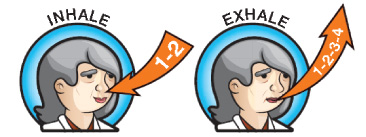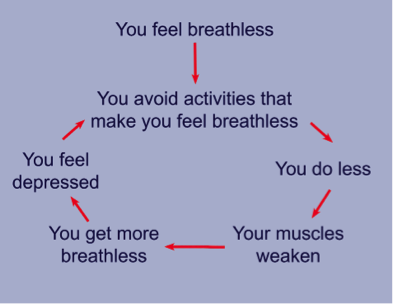
Before starting these techniques, ask your Health Care Provider if they are right for you.
Having COPD makes it harder to breathe. And when it’s hard to breathe, it’s normal to get anxious, making you feel even more short of breath. Chronic Obstructive Pulmonary Disease (COPD) is an umbrella term used to describe progressive lung diseases including emphysema, chronic bronchitis, refractory (non-reversible) asthma, and some forms of bronchiectasis.

There are two breathing techniques that can help you get the air you need without working so hard to breathe: Pursed-lips Breathing and Diaphragmatic (also called Belly or Abdominal) Breathing.
Better Breathing Tip: It’s normal to hold your shoulders tense and high. Before starting any breathing technique, take a minute to drop your shoulders down, close your eyes, and relax.
Pursed-Lips Breathing
- Slows your breathing down
- Keeps airways open longer so your lungs can get rid of more stale, trapped air
- Reduces the work of breathing
- Increases the amount of time you can exercise or perform an activity
- Improves the exchange of oxygen and carbon dioxide
- Breathe in through your nose (as if you are smelling something) for about 2 seconds.
- Pucker your lips like you’re getting ready to blow out candles on a birthday cake.
- Breathe out very slowly through pursed-lips, two to three times as long as you breathed in.
- Repeat.

Diaphragmatic (Abdominal/Belly) Breathing
The diaphragm is the main muscle of breathing. It’s supposed to do most of the work. When you have COPD, the diaphragm doesn’t work as well and muscles in the neck, shoulders and back are used. These muscles don’t do much to move your air. Training your diaphragm to take over more “work of breathing” can help.Diaphragmatic breathing is not as easy to do as pursed-lips breathing. It is recommended that you get instruction from a respiratory health care professional or physical therapist experienced in teaching it.
This technique is best used when you’re feeling rested and relaxed, and while sitting back or lying down.
- Relax your shoulders.
- Place one hand on your chest and the other on your belly.
- Inhale through your nose for about two seconds.
- As you breathe in, your belly should move outward. Your belly should move more than your chest.
- As you breathe out slowly through pursed-lips, gently press on your belly. This will push up on your diaphragm to help get your air out.
- Repeat.
Better Breathing Tip: Stop, Reset, Continue
When you are feeling short of breath during exercise or regular activities, use these 3 steps:- Stop your activity.
- Reset by sitting down, relax your shoulders, and do pursed-lips breathing until you catch your breath.
- Continue activity, doing pursed-lips breathing as you go. Go at a slower pace if you need to.
Staying Healthy and Avoiding Pneumonia
What is pneumonia?
Pneumonia is an infection of one or both lungs. Organisms settle in the air sacs where they grow rapidly. These air sacs become filled with pus and fluid as the body attempts to fight infection. Young children, cigarette smokers, adults over 65 and people with certain medical problems including COPD are at greater risk for developing pneumonia. COPD is the third leading cause of death, while pneumonia and flu contribute to the eighth leading cause of death in the United States.What causes pneumonia?
Pneumonia is most commonly caused by bacteria, viruses and less commonly fungi which are more common in patients with suppressed immune systems. Contact with the organisms occurs either through directly touching objects with your hands (which then transmit the organism to your mouth, nose or eyes), or through inhalation of droplets containing the organisms. The causes of pneumonia for which vaccines (shots) are available include:- Influenza (Flu)
- Pneumococcus
- Measles
- Pertussis (whooping cough)
- Haemophilus influenzae type b (Hib)
Symptoms of pneumonia:
There are several symptoms of pneumonia that are similar to those of a COPD flare-up, which are often caused by infection. It is important to recognize these pneumonia symptoms and to call your doctor if you experience one or more of the following:- Fever over 100.5 degrees or shaking chills
- Shortness of breath or more rapid breathing
- Nausea, vomiting or diarrhea
- Cough with increased amount of mucus
- Cough with a change in mucus color
- More rapid heart rate
- Pain in one area of the chest with deep breaths
How can I avoid pneumonia?
- See your health care professional at your regularly scheduled appointment even if you feel fine
- Get your flu shot every year. Local pharmacies and grocery stores offer these shots at the start of flu season
- Check if you are due for a pneumonia shot which can greatly reduce your risk of developing pneumonia
- Wash your hands often and carry a small bottle of hand sanitizer for when you cannot wash your hands
- Avoid touching your mouth, eyes, and nose in public to help prevent germs from entering your body
- Stay away from crowds, especially during cold and flu season
- Use your own pen, especially when signing in at your doctor’s office or other health care appointments
- Don’t smoke as it makes it harder for the lungs to fight off an infection
- Get plenty of sleep. When your body is tired, you're more likely to get sick

No comments:
Post a Comment